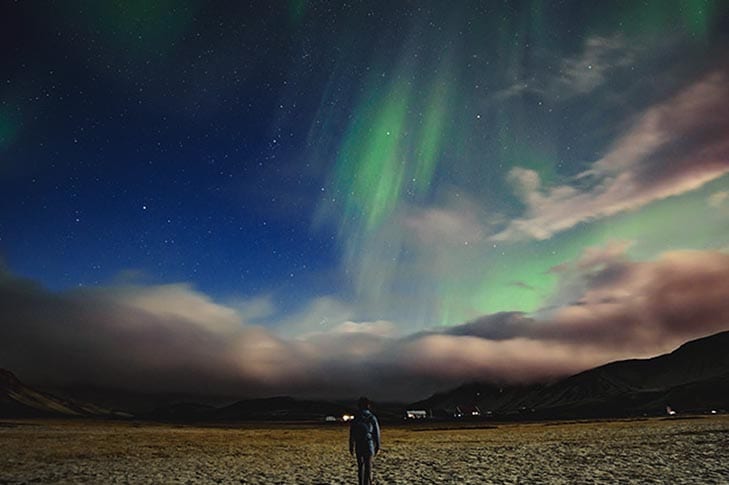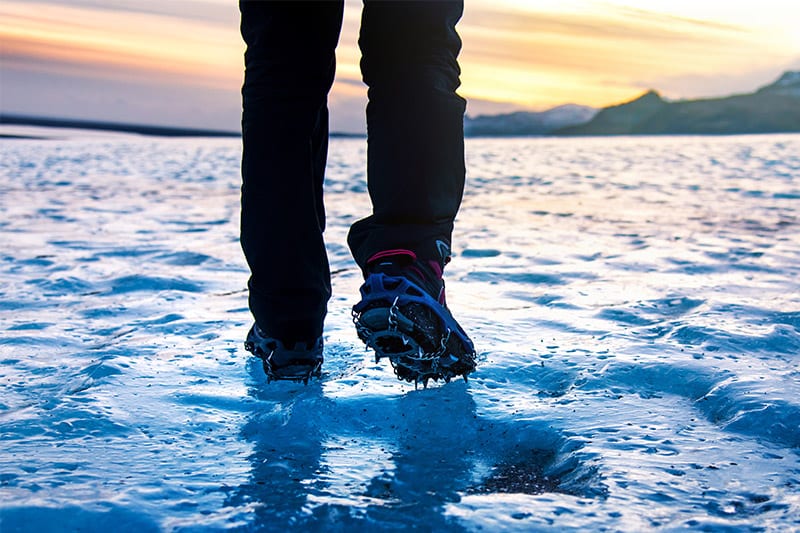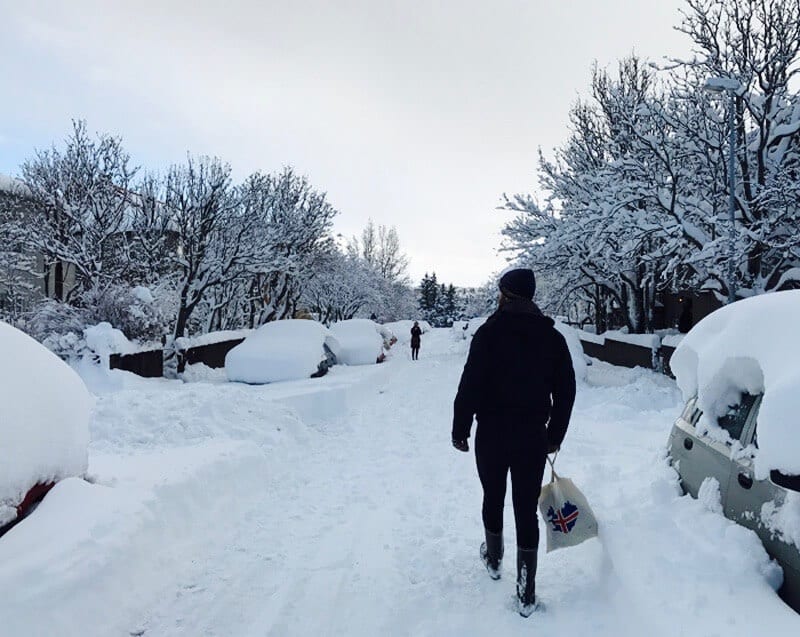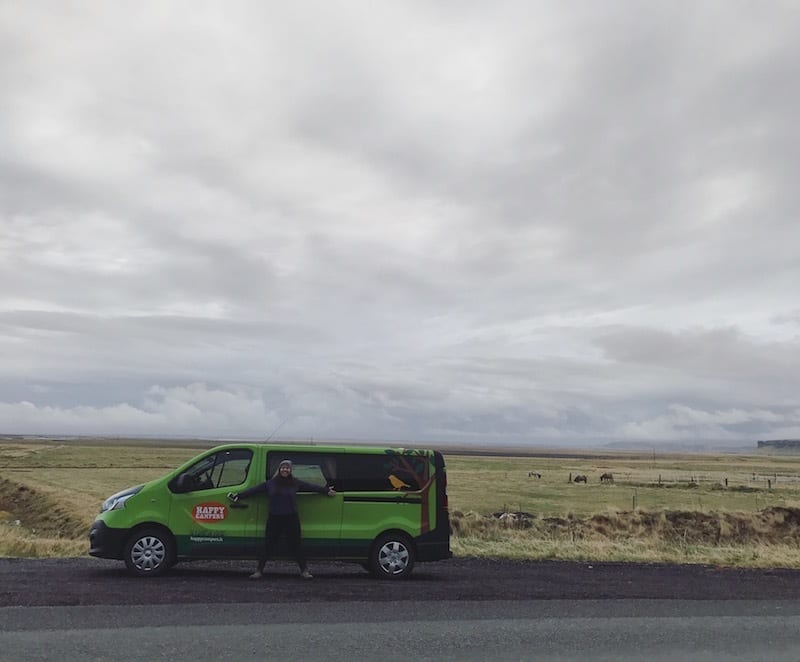Iceland in winter is gloriously and unapologetically wild. The kind of place where snowflakes sting your cheeks, geysers steam against crimson skies (dusk and dawn), and every stop-off looks like the perfect photo op.
Yet, amidst all that magic, one misjudged packing decision can turn adventure into agony (or at least some grumbly annoyance). Forget the influencer nonsense; this is a land in the Arctic that respects those who come prepared. Whether you’re braving the Ring Road in one of our trusty campervans or simply hunting the Northern Lights, this guide will help you pack smart, stay warm, and look only slightly windswept while doing it (general hygiene is up to you).
Why packing smart for Iceland in winter actually matters

The first crack of light in Reykjavík in December appears between ten and eleven in the morning, and by three in the afternoon, it’s negotiating with dusk. Icelandic winter is nothing if not dramatic, and utterly unforgiving if you arrive underdressed (though I’m not implying there is a dress code).
This is a land where wind can knock the breath from your lungs, sleet can arrive from pretty perplexing positions, and the sun, bless it, makes only brief cameo appearances. Your packing choices will determine whether you spend your trip muttering through chattering teeth or gleefully sipping hot chocolate in your campervan while the Northern Lights dance above.
And since you’re planning to roam around Iceland in a campervan, with the freedom to chase the weather or flee it entirely, you’ll want to pack cleverly. There’s no room for suitcase optimism here.
Thankfully, our team has already done most of the heavy lifting. Every campervan in our fleet comes equipped with thick duvets, cozy bedding, Webasto heating, a full kitchen setup, and even a winter kit with studded tyres, a shovel, and an ice scraper (no Shining experience for you no matter the destination).
In short, we’ve (our mechanics) eliminated the need for most of the heavy, awkward, or “just-in-case” items travellers tend to overpack. So, let’s talk about what you actually need to bring, and what you can leave at home with no second-guessing or domestic packing dramas.
The Golden Rule: Layer like an onion, not a tourist

The secret to thriving in Iceland’s winter weather is layering, and doing it well is an art form every visitor must master. The best way I can put it, is try to think of yourself as a walking thermos flask; your goal is to trap warmth without turning into a sweaty mess. The base layer is your silent guardian: merino wool or a synthetic fabric that hugs the skin, wicks away moisture, and dries quickly when the snow or rain (or both) decides to surprise you. Cotton, on the other hand, is an absolute traitor; it soaks up damp like a sponge and clings to you with malicious intent (another reason to avoid fast fashion).
On top of that goes your insulating layer. By that I mean a fleece or a wool jumper that keeps the warmth in without bulking you up like the Michelin Man. A lightweight down jacket or synthetic alternative is a wise addition for those long stops to admire all our wonders or, let’s be honest, wait for the Northern Lights to finally show.
The outer shell is where the magic happens: waterproof, windproof, and ideally breathable enough that you don’t end up feeling like a sauna on legs (it won’t help you get a tan either). Invest in quality here; Iceland’s gales have shredded more than a few budget raincoats. Those fashionable, “packable” ponchos should be considered one-way tickets to becoming an airborne tourist (or at least, it won’t help and you’ll look like a muppet, because Iceland isn’t Disney World).
Inside your Happy Campers campervan, things shift gears entirely. With the Webasto heating system humming softly and thick duvets cocooning you in warmth, the layering game can relaxe a tad. Base layers and a fleece are all you need for a snug night of hot chocolate, cards, and questionable road-trip playlists.
But once you step outside, whether you’re wandering at the base of frozen waterfalls, stumbling along paths in Skatafell Nature Reserve, or just daring to face the wind at Þingvellir, proper outerwear becomes your shield. Iceland doesn’t reward the brave; it rewards the prepared (and the onions).
What to wear on your feet (forget fashion)

Forget style, this is not Milan. Take it from me, it’s a frozen island where practicality reigns supreme. Icelandic winter is brutal on footwear, and your shoes will either be your salvation or your downfall.
What you need are solid, waterproof hiking boots that rise above the ankle, provide a firm grip, and laugh in the face of slush (if it were literally it would be more awesome). Break them in before your trip unless you fancy spending your first day hobbling across Reykjavík’s pavements with some fun fun blisters.
Wear them with merino or wool-blend socks, ideally several pairs, because once they’re wet, they’re not drying anytime soon (there’s only so much the heaters can dry). Liner socks can be a quiet blessing, adding an extra layer of warmth and reducing friction. Remember, this isn’t about completing your best mimic of Derek Zoolander; it’s about keeping your toes intact (also, nothing annoys me more than cold toes when Aurora hunting).
The ground here is not to be underestimated. Even in the city, pavements can turn into ice rinks without warning, and one ill‑timed step can result in an unplanned meeting with the floor (and maybe a doctor with a funny Nordic accent).
A solid pair of no-nonsense crampons will keep you sound. They’re small, easy to carry, and can often be bought in local supermarkets like Bónus in winter. They’re especially vital if you’re planning to explore frosty waterfall regions, glacier regions, national parks covered in snow, or any of Iceland’s countless slippery wonders. You can rent them locally, but many travellers prefer to bring their own after one slip too many (*cough*, mum).
Key items for your Icelandic winter footwear arsenal:
- Sturdy, waterproof hiking boots with good ankle support
- Wool or merino-blend hiking socks (multiple pairs)
- Thin liner socks to prevent blisters and add warmth
- Crampons for icy surfaces
- Extra insoles for added insulation and comfort (not essential, but handy)
In short, treat your feet as your most precious travel companions, because once they’re miserable, so are you (and for the Tolkien fans among you, as much as you can quote the film, you’re still not a Hobbit).
Winter accessories that keep you functioning

If the devil is in the details, then so is your survival in Icelandic winter. The right accessories keep you functional. A wool or fleece-lined hat that actually covers your ears is non-negotiable, and gloves are worth doubling up on: one insulated pair for general use and a waterproof pair for when the grey and black clouds decide it’s time to say “hey”.
Scarves, buffs, or neck warmers seal off that gap between jacket and chin where the cold wind loves to sneak in, and thermal underwear adds a comforting layer that can make a miserable day downright manageable. And, if you’re like me with absolutely no shame and enjoy nothing more than making your significant other cringe, a pair of Long Johns also goes a long way.
Sunglasses might seem like an odd addition to a winter list, but trust me, they’re vital. The low Icelandic sun has a talent for bouncing light straight into your eyes, and glare from snow can be as punishing as a mid-summer beach day (and worse when you’re driving into it). Protecting your eyes means fewer headaches and fewer fake smiles in your photos.
To make life easier, here’s a quick reminder of what to pack before the chill sets in:
Key winter accessories to bring:
- A warm, wool or fleece-lined hat that covers your ears
- Two pairs of gloves (one insulated and one waterproof)
- A buff, scarf, or neck warmer for wind protection
- Thermal underwear for added warmth and comfort (or Long Johns)
- Sunglasses with UV protection (snow glare can be more than annoying)
- Hand and toe warmers for particularly cold days
These small additions may not take up much space in your bag, but they’ll make the difference between a shivering tourist and a contented explorer, snugly ready for Iceland’s wild winter embrace (and by embrace I mean, locking you in our snowglobe fridge).
The campervan-specific packing list (and what we already give you)

This is where things get easier. Your Happy Campers campervan already includes most of the essentials: a gas stove with canisters that last up to two weeks, a sink with running water, pots, pans, dishes, and cutlery. You’ll also find a cooler, USB chargers, a Bluetooth stereo for your road trip soundtrack (don’t bring a mixtape, this isn’t the 80’s), and that glorious Webasto heater keeping the cabin toasty. Bedding, pillows, duvets, and extra blankets? All included. Which means you don’t need to bring half your bedroom from home, or stumble confused with crampons on in IKEA (not that that happens…much).
What you should pack are the personal bits: your own reusable water bottle, a small thermos for on-the-go coffee, a few easy-to-cook meal ingredients for your first night, and any snacks you can’t live without (Cadbury’s chocolate tends to disappear fast in Iceland).
Pack some resealable bags to keep things dry, and perhaps a microfibre towel. Preferably the kind that dries quickly after a dip in a hot spring (which is so much more fun in winter with the Aurora dancing above). Most other things you’ll find either in your campervan or at one of Iceland’s many well-stocked supermarkets.
The extras list from our team is also worth a look before you fly. You can add on WiFi (if it’s not already included in your model), extra duvets, camping chairs, even coffee presses and BBQ kits, though, let’s be honest, the latter is for the bold and the frost-tolerant (Icelanders BBQ all year-round). All in all, our campers are so well-equipped that packing becomes less about survival and more about comfort. Plus, for the Noel Gallaghers among you, you can also rent a guitar (apologies to your family and friends in advance for promoting that).
Key campervan items and essentials to remember:
- Reusable water bottle and a small thermos for hot drinks
- Easy-to-cook meal ingredients and your favourite snacks (local supermarkets will have you covered or provide decent substitutes)
- Resealable bags or containers to keep food and clothing dry
- Microfibre towel for cheeky dips or campsite showers
- Power bank or portable charger for backup energy
- Reusable shopping bags for grocery stops
- A head torch or small lantern for dim evenings in the van (better with red light settings for the photographers among you)
These small touches transform a basic road trip into a comfortable, seamless winter adventure. When you’ve got everything you need within arm’s reach and a heater humming in the background, Iceland suddenly feels a lot more hospitable (and less of a vast cold frozen tundra).
Tech and travel gear that actually helps

Iceland is next-level photogenic. Every horizon begs to be photographed, and every waterfall has its own personality. If you’re planning to capture this winter wonderland, you’ll need more than just enthusiasm. Bring a proper camera if you can. A DSLR or mirrorless model will handle low light far better than your phone, no matter how good an online review gave it (or my understanding of quantum mechanics is flawed).
Remember to pack spare batteries and memory cards, as cold weather saps power faster than dad jokes deliver eye rolls. A sturdy tripod is essential for those long Northern Lights exposures, and lens cloths will save your shots from mist (if near the sea), snowflakes, and sea spray (just be quick if you’ve got a timelapse set up).
Portable chargers and power banks are worth sneaking in last-minute suitcases, especially on longer days exploring glaciers, ice caves, or lava fields. While your campervan is well-equipped with USB ports to keep most gadgets alive, redundancy is a traveller’s best friend.
For navigation, Google Maps works wonderfully (though I’m not sure you can pack it), but Iceland’s more remote corners can make even the best signal disappear, so always download offline maps before venturing into the wild (wild = outside of Reykjavík). Fortunately, all our campers have a GPS safety tracker and weather warning system, keeping you one step ahead of the elements (and any drama the skies might cook up).
Again, maybe not tech-related (unless you happen to be my mother), but don’t forget a head torch. With up to 20 hours of darkness in deep winter, light becomes your most precious tool. Reflective clothing or accessories might not make you runway-ready, but they can quite literally save your life when exploring near roadsides or dim car parks. Safety might not be sexy, but in Iceland, it’s non-negotiable, and it doesn’t take a holiday (I’m not saying make safety sexy).

Essential tech and travel gear to pack:
- Camera (DSLR, mirrorless, or a kicka** phone) and extra memory cards
- Spare batteries (and keep them warm in your pockets to preserve charge)
- A sturdy tripod for Northern Lights photography (or any longer exposures)
- Lens cloths or wipes for snow and mist
- Portable power banks and chargers
- Offline maps downloaded to your phone
- Head torch for dark nights (not just to scare your spouse or friends)
- Reflective bands, vests, or accessories for visibility
These essentials ensure you stay powered, visible, and camera-ready while navigating Iceland’s breathtaking and regularly unpredictable winter landscapes.
Toiletries and personal care in Iceland’s winter chill
The dry, Arctic air does terrible things to skin, so bring a rich moisturiser and lip balm. Even tough types end up buying some halfway through the trip (my knuckles bleed every winter like clockwork, and I’m mostly a writer). A small bottle of leave-in conditioner will also help fight off the effects of cold wind and sulphur-rich hot springs.
Also pack a toothbrush, toothpaste, deodorant (the usual three amigoes), but choose travel-sized items to save space. Quick-dry towels are brilliant for dips in everything from hot springs to local swimming pools. And if you take any medication, keep it somewhere easily accessible rather than buried under your socks; some remote pharmacies operate on limited hours (but, on the plus side, their medicine won’t smell like socks).
Essential toiletries and personal care items to pack:
- Rich moisturiser and nourishing lip balm to combat dry air
- Leave-in conditioner or hair oil for post-pool care
- Travel-sized toothpaste, toothbrush, deodorant, and soap
- Quick-dry towel for hot springs or campsite use
- Suncream (yes, even in winter, the snow glare can burn)
- Hand sanitiser and wet wipes for on-the-go freshness (you never know how grim a bar toilet can be at times)
- Personal medication (first-aid kits are in all our campers)
These essentials might seem simple, but they make a world of difference when the elements turn fierce and the air starts feeling like fine sandpaper on your skin. However, you can mostly pick this up when you arrive.
What not to pack for Iceland in winter

Now for the fun part, what you absolutely do not need. Iceland might be dramatic, but your luggage doesn’t have to be. There’s a long list of things that first-timers think they’ll need and later regret packing. High heels, for instance, have no business existing anywhere near Icelandic ice despite what some young locals may feel is right on a Saturday night.
Jeans, while beloved everywhere else, take hours to dry and become an icy cold torture device when wet. Love your fancy evening wear? Leave it in the wardrobe; even Reykjavík’s trendiest restaurants lean more toward casual and comfortable than any brand standoffs. You can also skip the piles of bottled water (please save yourself the kronos), because Icelandic tap water is some of the purest in the world, straight from the ultimate glacial sources. Bring a reusable bottle instead and fill it as you go.
A few other things can also stay home: excessive electronics, too many changes of shoes, and half your skincare routine. Space inside a campervan is precious, and less clutter means a calmer, more enjoyable road trip (for everyone). The goal isn’t to live out of a suitcase, but to live freely and comfortably on the road, without being buried in unnecessary extras you thought you should take just in case.
Things you can confidently leave off your Iceland winter packing list:
- High heels or any other non-practical footwear
- Jeans or heavy cotton trousers that take forever to dry
- Fancy or formal evening clothes
- Excess bottled water (tap water here is already perfect…and free!)
- Multiple pairs of shoes (one good pair of boots will do the trick)
- Excessive electronics or unnecessary gadgets
- Overly bulky luggage or large suitcases
- Fragile accessories or jewellery that will only get in the way (after all, people don’t come here for the city life)
Travelling light in Iceland should be liberating. The less you bring, the less you have to worry about, and the more you can focus on the good stuff: the landscapes, the freedom, and the sheer thrill of the open Icelandic road caked in snow from every direction, chasing cloud gaps to see the Northern Lights (or just to avoid any snowstorms).
Local tips from your friendly neighbourhood Happy Campers

Icelandic weather is a fickle beast, and that’s putting it politely. One moment you’re basking in sunshine; the next, you’re in a snow globe that someone’s violently shaken. But there are ways to make life easier on the road.
When drying clothes inside your van, try to hang them up high. After all, as science teaches us, warm air rises and will work its quiet magic faster than you’d think. If you need to speed things up, place damp socks or gloves near the heater (but not so close that the sock smell decides to express itself around the camper).
To fend off that pesky condensation that loves to gather overnight, crack a window slightly before bed. It might sound counterintuitive, but a bit of airflow can be the difference between waking up refreshed and waking up in a mobile sauna with some passersby in the campsite feeling nosy.
When you need to restock, towns like Selfoss, Akureyri, and Egilsstaðir are your trusty supply stops outside of Reykjavík, with bits and bobs less consistently in some of the towns you’ll pass through. Hagkaup, Kronan, N1 gas stations, and Bónus carry everything from hiking socks to gas canisters, and often some delightful Icelandic chocolate for morale.
Our private campsite map will point you to the best overnight stops, which our in-house team of vanlife-loving wanderers recommends, many with shared indoor kitchens, drying rooms, and warm showers (all showers in Iceland are warm, enjoy them), which become a kind of luxury spa after a day of exploring the glacier lagoons, ice caves, fjords, trolls, waterfalls, and mountain peaks.
It also pays to know your tech sources. Iceland’s weather apps are almost as unpredictable as the weather itself; treat them as suggestions rather than gospel. Always double-check forecasts and road conditions on SafeTravel.is and the Icelandic Road Administration before setting out.
And should the elements decide to test your mettle, remember that Happy Campers’ 24/7 emergency phone assistance and GPS tracker mean you’re never truly alone on the road, even in the most remote corner of the island (best not to bring Ed Snowden with you; he might get mad).
Handy local tips from the Happy Campers team:
- Hang clothes up high in the van to dry faster
- Keep airflow going overnight to reduce condensation
- Restock essentials in larger towns like Selfoss, Akureyri, or Egilsstaðir
- Use campsite facilities for extra comfort, including drying rooms and kitchens
- Double-check the weather and road conditions before driving
- Keep Happy Campers’ emergency contact details handy, just in case (we will brief you in the office before you head out, so there’s no stress)
A bit of preparation and local know-how transforms a challenging winter trip into an exhilarating one, the kind of adventure you’ll be bragging about long after your boots have thawed (assuming you’re not visiting us from Svalbard or the Disney Frozen movie franchise).
Conclusion: Pack smart, travel happy
Travelling in Iceland in winter is one of those rare adventures that’s the perfect cocktail of beauty and brutality (gin & tonic). With the right items, a warm campervan, and a sense of humour, you’ll fall in love with this icy paradise (ok, more unique rocky land). Pack smart, embrace the chaos, and let our team handle the rest. Our award-winning vans, winter-ready vehicles, and endless freedom mean you can chase all the nature Iceland has to offer without a single worry. Just remember: Iceland rewards those who prepare, and punishes those who pack jeans (sorry, Calvin Klein).
Back